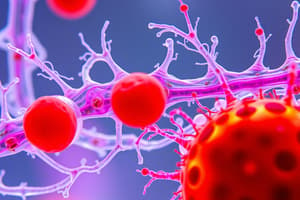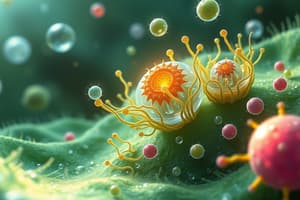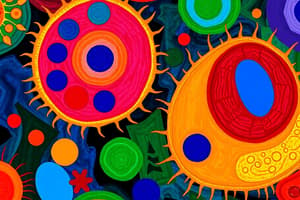Podcast
Questions and Answers
Which of the following statements accurately reflects the cell theory?
Which of the following statements accurately reflects the cell theory?
- Cells can spontaneously generate.
- All cells are identical.
- All cells arise from living cells.
- All living organisms are made up of one or more cells. (correct)
Robert Hooke was the first to observe living cells.
Robert Hooke was the first to observe living cells.
False (B)
What is the primary function of the nucleus in a cell?
What is the primary function of the nucleus in a cell?
To control the cell's activities and contain genetic material.
The _____ provides structural support and protection to plant cells.
The _____ provides structural support and protection to plant cells.
Match the following cell components with their respective functions:
Match the following cell components with their respective functions:
Which of these organisms is an example of a unicellular organism?
Which of these organisms is an example of a unicellular organism?
Cell organelles are similar in function to organs in a human body.
Cell organelles are similar in function to organs in a human body.
Name one scientist who contributed to the discovery of cells and their contribution.
Name one scientist who contributed to the discovery of cells and their contribution.
Which organelle is primarily responsible for energy production in the cell?
Which organelle is primarily responsible for energy production in the cell?
Lysosomes have a double-membrane structure.
Lysosomes have a double-membrane structure.
What is the process called where a parent cell divides into two daughter cells?
What is the process called where a parent cell divides into two daughter cells?
The __________ are responsible for the breakdown of waste materials in a cell.
The __________ are responsible for the breakdown of waste materials in a cell.
Match the following structures with their functions:
Match the following structures with their functions:
What is the primary function of the Golgi Apparatus?
What is the primary function of the Golgi Apparatus?
Plastids are found in both plant and animal cells.
Plastids are found in both plant and animal cells.
What term is used for the larger, central storage structure found in plant cells?
What term is used for the larger, central storage structure found in plant cells?
Animal cells use the process of __________ for reproduction.
Animal cells use the process of __________ for reproduction.
Which of the following statements about osmosis is true?
Which of the following statements about osmosis is true?
What is the largest cell in the world?
What is the largest cell in the world?
All cells have a nucleus.
All cells have a nucleus.
What process involves the movement of water across a semi-permeable membrane?
What process involves the movement of water across a semi-permeable membrane?
The membrane transporting substances that requires energy is called _____ transport.
The membrane transporting substances that requires energy is called _____ transport.
Match the following cell organelles with their functions:
Match the following cell organelles with their functions:
Which type of transport moves substances from a region of lower concentration to a region of higher concentration?
Which type of transport moves substances from a region of lower concentration to a region of higher concentration?
Plant cells have a cell wall that provides structure and rigidity.
Plant cells have a cell wall that provides structure and rigidity.
What is the function of ribosomes in a cell?
What is the function of ribosomes in a cell?
The _____ solution has a higher solute concentration than the cell.
The _____ solution has a higher solute concentration than the cell.
Match the following types of solutions with their descriptions:
Match the following types of solutions with their descriptions:
Which of the following statements is NOT true about eukaryotic cells?
Which of the following statements is NOT true about eukaryotic cells?
The Golgi apparatus plays a significant role in protein synthesis.
The Golgi apparatus plays a significant role in protein synthesis.
What are the two types of endoplasmic reticulum?
What are the two types of endoplasmic reticulum?
_____ are known as the suicidal bags of the cell.
_____ are known as the suicidal bags of the cell.
What happens to a cell placed in a hypotonic solution?
What happens to a cell placed in a hypotonic solution?
Flashcards
What is a cell?
What is a cell?
The fundamental unit of life, the building block of all living organisms.
Cell Theory
Cell Theory
A theory stating that all living organisms are made up of one or more cells, cells are the basic structural and functional units of all living organisms, and all cells arise from pre-existing cells.
Unicellular organism
Unicellular organism
Organisms made up of a single cell.
Multicellular organism
Multicellular organism
Signup and view all the flashcards
What is the plasma membrane (cell membrane)?
What is the plasma membrane (cell membrane)?
Signup and view all the flashcards
What is the cytoplasm?
What is the cytoplasm?
Signup and view all the flashcards
What is the nucleus?
What is the nucleus?
Signup and view all the flashcards
What is the cell wall?
What is the cell wall?
Signup and view all the flashcards
Cytoplasm
Cytoplasm
Signup and view all the flashcards
Endoplasmic reticulum (ER)
Endoplasmic reticulum (ER)
Signup and view all the flashcards
Rough ER
Rough ER
Signup and view all the flashcards
Smooth ER
Smooth ER
Signup and view all the flashcards
Golgi apparatus
Golgi apparatus
Signup and view all the flashcards
Lysosomes
Lysosomes
Signup and view all the flashcards
Vacuoles
Vacuoles
Signup and view all the flashcards
Mitochondria
Mitochondria
Signup and view all the flashcards
Plastids
Plastids
Signup and view all the flashcards
Mitosis
Mitosis
Signup and view all the flashcards
Cell Membrane
Cell Membrane
Signup and view all the flashcards
Membrane Transport
Membrane Transport
Signup and view all the flashcards
Passive Transport
Passive Transport
Signup and view all the flashcards
Endosmosis
Endosmosis
Signup and view all the flashcards
Exosmosis
Exosmosis
Signup and view all the flashcards
Hypertonic Solution
Hypertonic Solution
Signup and view all the flashcards
Hypotonic Solution
Hypotonic Solution
Signup and view all the flashcards
Isotonic Solution
Isotonic Solution
Signup and view all the flashcards
Cell Wall
Cell Wall
Signup and view all the flashcards
Plasmolysis
Plasmolysis
Signup and view all the flashcards
Nucleus
Nucleus
Signup and view all the flashcards
Chromatin
Chromatin
Signup and view all the flashcards
Chromosomes
Chromosomes
Signup and view all the flashcards
Prokaryotic Cells
Prokaryotic Cells
Signup and view all the flashcards
Eukaryotic Cells
Eukaryotic Cells
Signup and view all the flashcards
Study Notes
Introduction to Cells
- Introduction to the cell, fundamental unit of life, for Class 9 students.
The Cell: Fundamental Unit of Life
- The cell is the basic building block of all living organisms.
- All living organisms are composed of cells.
- Cells are the fundamental units of life because all functions of a living organism begin at the cellular level.
Cell Theory
- Cells are the basic structural and functional units of all living organisms.
- All organisms are made up of one or more cells.
- All cells arise from pre-existing cells.
- This theory was developed by Schleiden, Schwann, and Virchow.
Types of Organisms Based on their Cellular Structure
- Unicellular Organisms: Organisms made up of a single cell.
- Examples: Bacteria, Amoeba, Paramecium
- Multicellular Organisms: Organisms made up of multiple cells.
- Examples: Humans, animals, plants
History of Cell Discovery
- Robert Hooke: Discovered the cell in 1665.
- Observed dead cells in a thin slice of cork using a microscope.
- The cells observed were from a plant (cork).
- Antonie van Leeuwenhoek: First to observe living cells under a microscope.
- Robert Brown: Discovered the nucleus of the cell in 1831.
- Purkinje: Discovered the protoplasm of the cell in 1839.
Components of the Cell
- Plasma Membrane (Cell Membrane): Outer boundary of the cell.
- Acts as a gatekeeper, controlling what enters and exits the cell.
- Cytoplasm: Jelly-like substance inside the cell, containing cell organelles.
- Site of many chemical reactions.
- Nucleus: Control center of the cell.
- Contains the cell's genetic material (DNA), controlling all cell activities.
- Cell Organelles: Specialized structures within the cell performing specific functions.
- Like tiny organs within the cell.
- Cell Wall: Rigid outer layer in plant cells.
- Provides structural support and protection.
- Made of cellulose.
Importance of Cell Organelles
- Cell organelles perform specific functions, essential for the cell's survival and function.
The Cell: A Building Block of our Body
- Cells combine to form tissues.
- Tissues combine to form organs.
- Organs combine to form organ systems.
- Organ systems combine to form a complete organism.
Cell Size and Shape
- Cell size and shape vary based on species and function.
- Largest cell: Ostrich egg
- Smallest cell: Mycoplasma (type of bacteria).
Key Fact
- The importance of studying science is emphasized in the text, with a focus on engaging teaching methods.
Cell Membrane
- Outermost covering of the cell.
- Separates the cell from its surroundings.
- Controls what enters and exits the cell.
- Also known as the plasma membrane.
- Selective permeable membrane; selectively allows substances in and out of the cell.
- Made of lipids and proteins.
Membrane Transport
- Movement of substances across the cell membrane.
- Two types:
- Passive transport: Movement from high to low concentration, no energy required.
- Active transport: Movement from low to high concentration, requires energy (ATP).
Passive Transport
- Two types:
- Diffusion: Movement of substances from high to low concentration.
- Osmosis: Movement of water from high to low concentration across a semi-permeable membrane.
Osmosis
- Two types:
- Endosmosis: Water enters the cell, causing it to swell.
- Exosmosis: Water exits the cell, causing it to shrink (shrivel).
Types of Solutions
- Hypertonic solution: Higher solute concentration than the cell.
- Hypotonic solution: Lower solute concentration than the cell.
- Isotonic solution: Same solute concentration as the cell.
Cell Wall
- Rigid outer layer in plant, fungi, and bacteria cells.
- Provides structural support and rigidity.
- Prevents cells from bursting during osmosis.
- Composition:
- Plant cells: Cellulose
- Bacteria cells: Peptidoglycan
- Fungi cells: Chitin
Plasmolysis
- Shrinkage of the living cell content in hypertonic solutions.
- Cell membrane pulls away from the cell wall as water exits the cell.
- Cell wall remains intact.
Functions of the Cell Wall
- Provides rigidity and strength to the cell, preventing bursting.
- Maintains cell shape.
- Protects from pathogens and environmental stress.
Differences Between Plant and Animal Cells
- Plants have rigid cell walls for structural support.
- Animals lack cell walls due to mobility requirements.
Cell Wall (updated)
- Provides structural support and rigidity to plant cells.
- Plant cells are immobile, needing a rigid, tough outer layer for support.
Nucleus
- Control center of the cell.
- Enclosed by a double-layered nuclear membrane with pores for material exchange.
- Houses DNA, the genetic material defining organism traits.
- DNA is a thread-like structure.
- DNA controls eye color and hair type.
- Controls cell reproduction and development.
Chromatin & Chromosomes
- Chromatin: Thread-like, uncoiled DNA in the nucleus.
- Chromosomes: Condensed, coiled DNA during cell division.
- Chromosomes are paired DNA.
Prokaryotic & Eukaryotic Cells
- Prokaryotic: Smaller, lack a defined nucleus, nucleoid region for DNA, single chromosome, lack membrane-bound organelles.
- Eukaryotic: Larger, defined nucleus containing multiple chromosomes, membrane-bound organelles.
Ribosomes
- Protein synthesis factories in the cell.
- Found in both prokaryotic and eukaryotic cells.
- Lack a membrane.
Endoplasmic Reticulum (ER)
- Network of membranes in the cytoplasm.
- Involved in lipid and protein synthesis, transport and modification.
- Rough ER: Protein production
- Smooth ER: Lipid production, detoxification of harmful substances.
Golgi Apparatus
- Processes, packages, and transports cellular products in vesicles.
- Involved in protein modification, storage, and packaging.
- Assists in lysosome formation.
Lysosomes
- "Suicide bags" of the cell.
- Contain digestive enzymes to break down waste and cellular debris.
- Formed from the Golgi apparatus.
- Break down worn-out cell parts and ingested food.
- Can digest the entire cell if needed.
Cytoplasm
- Fluid content of the cell, enclosed by the cell membrane.
- Essential for cell processes and movements.
- Contains organelles.
Cell Organelles (updated)
- Endoplasmic Reticulum (ER): A network of membranes involved in lipid and protein synthesis.
- Rough ER: Protein production
- Smooth ER: Lipid production, detoxification.
- Golgi Apparatus: Packages and modifies cellular products in vesicles.
- Lysosomes: Digest waste and cellular debris, "suicide bags."
- Vacuoles: Store excess materials and water, maintaining turgor pressure in plant cells.
- Mitochondria: Energy production (ATP) through cellular respiration, contain their own DNA and ribosomes.
- Plastids: Found only in plant cells.
- Chloroplasts: Photosynthesis.
- Chromoplasts: Color to flowers/fruits.
- Leucoplasts: Store starch, oil, and proteins.
Cell Organelle Membranes
- Double-membrane bound organelles: Nucleus, Mitochondria, Plastids
- Single-membrane bound organelles: Vacuole, Lysosomes, Golgi apparatus, Endoplasmic reticulum
- Membrane-less organelles: Ribosomes, centrosomes
Cell Division
- Cell division: Process for producing new cells.
- Parent cell: Original cell
- Daughter cells: Cells produced from parent cell division.
- Mitosis: Division resulting in two daughter cells with the same chromosome number (growth and repair)
- Meiosis: Division creating four daughter cells with half the chromosome number (reproduction).
Table of Key Differences Between Plant and Animal Cells
(Table provided previously)
Osmosis Demo
- Dry apricots in pure water, then transferred to sugar solution.
- Water moves into apricots when in water, making them swell (endosmosis).
- Transferring to a sugar solution (hypertonic) causes water to move out, shrinking the apricots (exosmosis).
Studying That Suits You
Use AI to generate personalized quizzes and flashcards to suit your learning preferences.
Description
This quiz serves as an introduction to cells, the fundamental unit of life, specifically designed for Class 9 students. It covers the structure of cells, types of organisms, cell theory, and notable discoveries in cell history. Test your understanding of these essential concepts in biology!




